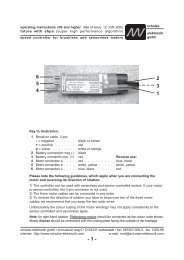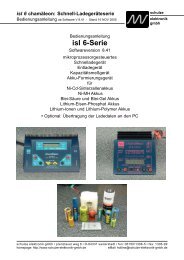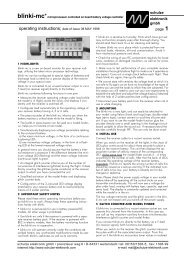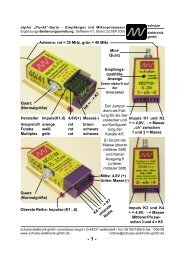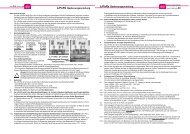isl 6 chameleon: rapid charger series - Schulze Elektronik GmbH
isl 6 chameleon: rapid charger series - Schulze Elektronik GmbH
isl 6 chameleon: rapid charger series - Schulze Elektronik GmbH
Create successful ePaper yourself
Turn your PDF publications into a flip-book with our unique Google optimized e-Paper software.
page 4<br />
3 Commonly used terms<br />
Final charge voltage: the voltage at which the battery's<br />
charge limit (capacity limit) is reached. The<br />
charge process switches from a high current to a<br />
low maintenance rate (trickle charge) at this point.<br />
From this point on further high current charging<br />
would cause overheating and eventual terminal<br />
damage to the pack.<br />
Final discharge voltage: the voltage at which the<br />
battery's discharge limit is reached. The chemical<br />
composition of the batteries determines the level of<br />
this voltage. Below this voltage the battery enters<br />
the deep discharge zone. Individual cells within the<br />
pack may become reverse-polarised in this condition,<br />
and this can cause permanent damage.<br />
Memory effect: A genuine memory effect has been<br />
recorded by Nasa, caused by repeated charge /<br />
discharge cycles. Nasa has found that full capacity<br />
can be regained by overcharging the cells. In modelling<br />
applications different effects are responsible<br />
for the reduction in cell capacity. The problem can<br />
be cured by balancing the cells (see below), and<br />
prevented by the measures described in Chapter 4.1.3.<br />
Balancing: a method of regaining full (nominal) capacity<br />
by alternately charging and discharging the<br />
pack, sometimes several times. This process is<br />
especially useful after a long period of non-usage<br />
(e.g. after purchase, or after several weeks without<br />
flying), and is also used to disperse the memory effect<br />
(see below). The effect of balancing is to break<br />
down the coarse crystaline structure (low capacity)<br />
inside the cell and convert it into a fine crystaline<br />
one (high capacity).<br />
Power-On (- reset): the status of the <strong>isl</strong> 6 after it<br />
has been connected to the car battery.<br />
Ready message: <strong>charger</strong> ready to run the program<br />
you have just selected (batteries not connected).<br />
C: Coulomb or capacity: Unit of measurement relating<br />
to the quantity of charged energy. In conjunction<br />
with charge current data this unit is used to determine<br />
the recommended / prescribed charge current<br />
of a battery of a given capacity. Example: if the<br />
charge current or discharge current of a 500 mAh<br />
battery is 50 mA, we refer to this as a charge or<br />
discharge at one tenth C (C/10 or 1/10 C).<br />
A, mA: unit of measurement relating to charge or<br />
dis-charge current. 1000 mA = 1 A (A=Ampere,<br />
mA=Milliampere)<br />
Ah, mAh: unit of measurement for the capacity of a<br />
battery (Amperes x time unit; h = hour). If a pack is<br />
charged for one hour at a current of 2 A, it has<br />
been fed 2 Ah of energy. It receives the same<br />
quantity of charge (2 Ah) if it is charged for 4 hours<br />
at 0.5 A, or 15 minutes (=1/4 h) at 8 A.<br />
<strong>isl</strong> 6 <strong>chameleon</strong>: <strong>rapid</strong> <strong>charger</strong> <strong>series</strong><br />
4 Useful information about<br />
batteries and maintenance<br />
4.1.1 General information:<br />
Do not store or charge below 0°C, optimum is 10...30°C.<br />
A cold cell is not capable of accepting as much current as a<br />
warm one. For this reason you must expect differences in<br />
charge characteristics if you use fully automatic charge current<br />
calculation (in Winter the charging properties will be worse<br />
than in Summer).<br />
The lower the internal resistance of the battery, the higher the<br />
<strong>charger</strong> can increase the charge current for that battery. For a<br />
battery <strong>charger</strong> which sets the current automatically the<br />
resistance of the cable is added to the internal resistance.<br />
For this reason: use heavy cable (large cross-section), even<br />
for receiver batteries, and keep them short. Do not charge<br />
via a switch or switch harness!<br />
If you wish to measure battery capacity accurately a suitable discharge<br />
current is usually 1/10 C.<br />
4.1.2 Reflex charging:<br />
Charging processes which include a brief discharge pulse definitely<br />
have the effect that the battery is several degrees cooler<br />
at the end of the process. However, from the point of view of<br />
the competition operator this is an undesirable effect, as the<br />
cell chemistry can only supply high currents if its temperature<br />
is raised to a certain extent.<br />
All these effects, whether they actually occur or are simply<br />
hear-say, have no practical significance if batteries are<br />
correctly handled in the first place. When a battery is full,<br />
you can’t fill it any fuller!<br />
4.1.3 Memory effect of Ni-Cd and Ni-MH cells:<br />
If cells are repeatedly stored partially discharged, or are<br />
recharged from a half-discharged state, what is known as the<br />
memory effect sets in. The cells note that their full capacity is<br />
not required, and react by refusing to make it available.<br />
One aspect of this is that the crystalline chemical structure<br />
inside the cell changes; the cell‘s resistance rises and its<br />
voltage collapses under load, with the result that “full capacity”<br />
can no longer be exploited at normal discharge currents.<br />
Even if reflex charging were to eliminate the memory effect, there<br />
is no denying the necessity to store your cells in the discharged<br />
state; this applies to Ni-Cd cells and also, to some<br />
extent, to Ni-MH* cells.<br />
Otherwise, a characteristic feature of these cells is that they<br />
self-discharge - and the rate of discharge is different for each<br />
individual cell in a battery pack!<br />
If a fully charged pack is left for a considerable time, it will<br />
eventually consist of cells of widely varying states of charge.<br />
If at this point you ...<br />
a) ... give the pack a full charge: the cell with the most charge<br />
will be overcharged, heat up and be ruined, while the cell with<br />
the least charge will still not be full after the same period of<br />
charging.<br />
b) ... discharge the pack: the cell with the least charge will be<br />
completely flat first, then reverse polarity and often suffer an<br />
internal short-circuit. At the point when this happens, the cell<br />
with the most charge is still not yet completely discharged.<br />
This is a reliable method of wrecking your most valuable<br />
packs - and rest assured that reflex charging will make<br />
absolutely no difference. However, there is one method of<br />
avoiding the problem: discharge cells after use, and recharge<br />
them just before use!<br />
[*] about Ni-MH cells: see Section 4.3<br />
schulze elektronik gmbh prenzlauer weg 6 D-64331 weiterstadt tel: 06150/1306-5, fax: 1306-99<br />
internet: http://www.schulze-elektronik.com e-mail: mail@schulze-elektronik.com



